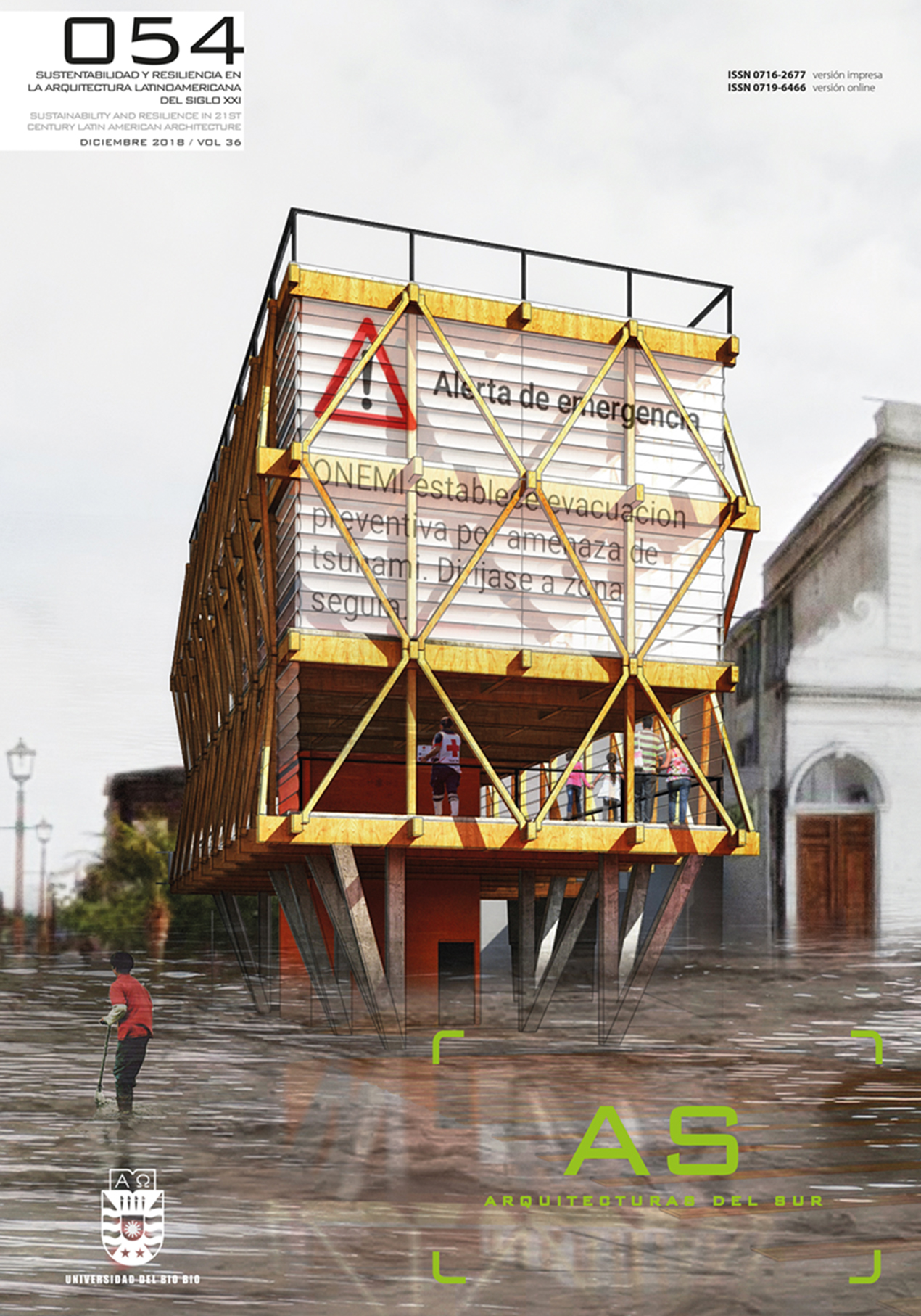Use, disuse and the characterization of the inbetween dimension as a potential area for rehabilitation. Three scales of approximation, analysis and diagnosis for the case of Valparaíso, Chile
DOI:
https://doi.org/10.22320/07196466.2018.36.054.03Keywords:
rehabilitation, territory, scales, analysis, sustainable developmentAbstract
The life of buildings over time and the phenomenon of obsolescence are clearly evident processes in the case of Valparaíso, Chile. Given the morphological characteristics and the associated ways of life, it is presumed that any rehabilitation action must take on a comprehensive approach by covering the material, functional, social and environmental dimensions. For the present study, exploratory research on how to improve this deterioration was carried out with the objective of developing a multiscale tool for characterizing problems and opportunities for sustainable architectural rehabilitation. Using a qualitative architectural analysis methodology, three potential areas for action were identified. Present in the “intermediate dimension,” they make it possible to plan an intervention and include: the potential for comfort, the ability for socio-spatial self-regeneration, and the opportunity for revitalization. With different socio-spatial reconstruction instruments and theoretical support, obsolescence diagnostics were prepared taking into consideration the pre-existing conditions, which lead to the formulation of new interventions.
Downloads
References
BENTLEY, Ian; ALCOCK, Alan; MCGLYNN, Sue; MURRAIN, Paul y SMITH, Graham. Entornos Vitales. Hacia un diseño urbano y arquitectónico más humano. Manual Práctico. 1ª ed. Barcelona: Editorial Gustavo Gili, 1999.
BUBER, Martin. ¿Qué es el hombre? México: Fondo de Cultura Económica, 1967.
CALDUCH, Juan. El declive de la arquitectura moderna: deterioro, obsolescencia, ruina, Palapa, 2009, vol. 4, pp. 29-43.
CALZADA, Igor; CHAUTÓN, Adolfo y DI SIENA, Domenico. #MacroMesoMicro. Marco Sistémico de Territorio desde la Innovación Social [en línea]. Edición propia, 2013. [Consultado 20 noviembre 2018]. Disponible en: http://macromesomicro.com
CARRASCO, Carolina. La espacialidad del encuentro. Análisis de las comunidades de los conjuntos habitacionales modernos en el caso chileno del Gran Valparaíso. Universidad Politécnica de Madrid, ETSAM, Departamento de Composición Arquitectónica, 2015.
CHACÓN, Eva. El reciclaje del hábitat social colectivo. Estrategias y tecnologías. Universidad de Granada, Escuela Técnica Superior de Arquitectura, Departamento de Construcciones Arquitectónicas, 2012.
FARIÑA, José. Ciudad sostenible, rehabilitación arquitectónica y regeneración urbana, Monografías de la Revista Aragonesa de Administración Pública, 2013, vol. XV, pp. 15-26.
GEHL, Jan. La humanización del espacio urbano: la vida social entre los edificios. 1ª ed. Barcelona: Editorial Reverté, 2006.
GOLDBERGER, Paul. Porqué la arquitectura importa. Madrid: Ivorypress, 2012.
HAUSLADEN, Gerhard; SALDANHA, Michael; LIEDL, Petra y SAGER, Christina. Climate Design. Solutions for buildings that can do more with less technology. München: Birkhauser, 2004.
HERTZBERGER, Herman. Lessons for students in Architecture. Rotterdam: Editorial 010 Publishers, 1991.
ITO, Toyo. Escritos. Murcia: Colegio oficial de aparejadores y arquitectos técnicos, 2000.
KAPSTEIN, Glenda. Espacios Intermedios: Respuesta arquitectónica al medio ambiente. Santiago: ARQ Ediciones, 2015.
LUCCHI, Elena. Sostenibilidad y eficiencia energética de los edificios históricos, PH: Boletín del Instituto Andaluz del Patrimonio Histórico, 2015, vol. 23, n° 88, pp. 230-242.
MONTANER, Josep; MUXÍ, Zaida y FALAGÁN, David. Herramientas para habitar el presente. La vivienda del siglo XXI. Barcelona: Universitat Politécnica de Catalunya, 2011.
NORBERG-SCHULZ, Christian. Existencia, Espacio y Arquitectura. Barcelona: Editorial Blume, 1975.
TUAN, Yi Fu. Space and Place. The perspective of experience. Londres: Ed. Arnold, 1977.
VAN EYCK, Aldo. On inside and outside space. En: VAN EYCK, Aldo; LIGTELIJN, Vincent y STRAUVEN, Francis. Aldo van Eyck Writings: collected articles and other writings 1947-1998. Amsterdam: SUN, 2008, p. 288.
VAN EYCK, Aldo. A home for Twin Phenomena. En: VAN EYCK, Aldo; LIGTELIJN, Vincent y STRAUVEN, Francis. Aldo van Eyck Writings: collected articles and other writings 1947-1998. Amsterdam: SUN, 2008, p. 61.
YAGÜE, José María. Revitalización vs Rehabilitación [en línea]. Ponencia presentada en Congreso Internacional de Rehabilitación y Sostenibilidad. El futuro es posible. Barcelona, 2010. [Consultado 16 octubre 2018]. Disponible en: www.rsf2010.org/files/u1/A18.pdf
Downloads
Published
How to Cite
Issue
Section
License
The content of the articles published in each issue of Arquitecturas del Sur is the sole responsibility of the authors and does not necessarily represent the opinion of University of the Bío-Bío.
The authors will maintain their copyright; however, they will guarantee the journal the right to first publication and dissemination of their work. The publication of the article in Arquitecturas del Sur will be subject to the Creative Commons International license (CC BY-SA) that allows others to adapt: remix, transform and build on the material for any purpose, even commercially; share: copy and redistribute the material in any medium or format, as long as the authorship and first publication in this journal are acknowledged by citing them correctly, and their new contributions are under a license with the same terms.














 Programa de Información Científica/Concurso Fondos de Publicación de Revistas Científicas 2018/ Proyecto Mejoramiento de Visibilidad de Revistas UBB (Código:FP180007)
Programa de Información Científica/Concurso Fondos de Publicación de Revistas Científicas 2018/ Proyecto Mejoramiento de Visibilidad de Revistas UBB (Código:FP180007) 
